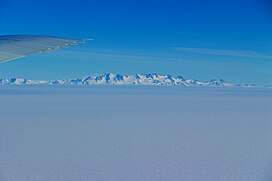|
Dufek Massif
The Dufek Massif (82°36′S 52°30′W / 82.600°S 52.500°W) is a rugged, largely snow-covered massif 27 nautical miles (50 km; 31 mi) long, standing west of the Forrestal Range in the northern part of the Pensacola Mountains, Antarctica.[1] Discovery and nameThe Dufek Massif was discovered and photographed on January 13, 1956, on a transcontinental patrol plane flight of United States Navy Operation Deep Freeze from McMurdo Sound to the vicinity of the Weddell Sea and return. It was named by the United States Advisory Committee on Antarctic Names (US-ACAN) for Rear Admiral George J. Dufek[a] United States Navy, who was in direct operational command of United States Navy Task Force 43 during that operation. The entire Pensacola Mountains were mapped by the United States Geological Survey (USGS) in 1967 and 1968 from ground surveys and U.S. Navy tricamera aerial photographs taken in 1964.[1] LocationThe Dufek Massif runs southwest-northeast in the northwest of the Pensalcola Mountains. It is to the east of the mouth of the Foundation Ice Stream, where it joins the Ronne Ice Shelf. It is south of the Ford Ice Piedmont. The Jaburg Glacier flows west past its southwest end, separating it from the Cordiner Peaks to the south. The Sallee Snowfield is to its east, separating it from the Forrestal Range. Major features, from southwest to northeast, include Neuburg Peak, Jaeger Table, Davis Valley and Boyd Escarpment.[4][5] Glaciers and snowfield
FeaturesGeographical features include:
Notes
References
Sources
|
||||||||||||||||||



